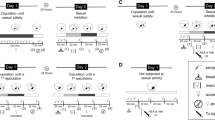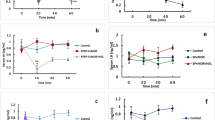Abstract
This study evaluates the effects of the IP injection of naloxone (0.3, 3 and 30 mg/kg) and naltrexone (0.2, 2 and 20 mg/kg) on the sexual satiation phenomenon. It was found that both antagonists exert a dose-based biphasic effect on the proportion of sexually exhausted rats displaying copulation. The intermediate doses of both opioid antagonists were more effective than the low and high doses in increasing the percentage of animals engaged in copulation. The analysis of the specific sexual behaviour parameters revealed that naloxone produces a slight inhibitory effect at the lowest dose, evidenced as an increase in the intromission number. The higher doses of this compound facilitated copulation reflected as a shortening of the ejaculation latency and the interintromission interval (III) and an increase in the copulatory rate. Naltrexone treatment had only facilitatory effects at the lower doses by reducing the III. The higher doses of naloxone (3 and 30 mg/kg) and the intermediate dose of naltrexone (2 mg/kg) decreased the spontaneous ambulatory behaviour of sexually satiated rats without impairing sexual behaviour execution. Data suggest a participation of the endogenous opioid systems in the sexual inhibition resulting from sexual exhaustion.
Similar content being viewed by others
References
Agmo A, Berenfeld R (1990) Reinforcing properties of ejaculation in the male rat: role of opioids and dopamine. Behav Neurosci 104: 177–182
Agmo A, Paredes R (1988) Opioids and sexual behaviour in the male rat. Pharmacol Biochem Behav 30: 1021–1034
Beach FA (1956) Characteristics of masculine “sex drive”. In: Jones MR (ed) The Nebraska Symposium of Motivation. University of Nebraska Press, Lincoln, Neb.
Beach FA, Jordan L (1956) Sexual exhaustion and recovery in the male rat. Q J Exp Psychol 8: 121–133
Clark JT, Smith ER, Davidson JM (1984) Enhancement of sexual motivation in male rats by yohimbine. Science 225: 847–849
Clark JT, Smith ER, Davidson JM (1985) Evidence for the modulation of sexual behaviour by alpha-adrenoceptors in male rats. Neuroendocrinology 41: 36–43
Fernández-Guasti A, Saldívar A (1991) Failure of naloxone to block the reduction in burying behaviour after ejaculation in male rats. Pharmacol Biochem Behav 38: 371–373
Forsberg G, Wiesenfeld-Hallin Z, Eneroth P, Södersten P (1987) Sexual behaviour induces naloxone-reversible hypoalgesia in male rats. Neurosci Lett 81: 151–154
Gessa GL, Paglietti E, Pellegrini-Quarantotti B (1979) Induction of copulatory behaviour in sexual inactive rats by naloxone. Science 204: 203–205
Greenberg A (1984) Effects of opiates on male orgasm. Med Aspects Hum Sexuality 18: 207–210
Graevert P, Goldstein A (1977) Effects of naloxone on experimentally induced ischemic pain and on mood in human subjects. Proc Natl Acad Sci USA 74: 1291–1294
Hetta J (1977) Effects of morphine and naltrexone on sexual behaviour of the male rat. Acta Pharmacol Toxicol 41: 53–61
Jaffe JH, Martin WR (1992) Opioid analgesics and antagonists. In: Goodman Gilman A, Rall TW, Nies AS, Taylor P (eds) The pharmacological basis of therapeutics (vol. 1). McGraw Hill, New York, pp 485–521
Jones H, Jones H (1977) Sensual drugs: deprivation and rehabilitation of the mind. Cambridge University Press, Cambridge
Kumar R, Mumford L, Texeira A (1977) Sexual behaviour in morphine dependent rats. Br J Pharmacol 62: 389–390
Kwong LL, Smith ER, Davidson JM, Peroutka S (1986) Differential interactions of “prosexual” drugs with 5-HT1A and alpha2 adrenergic receptors. Behav Neurosci 100: 664–668
Larsson K (1956) Conditioning and sexual behaviour in the male albino rat. Almqvist and Wiksell, Stockholm
Lieblich I, Baum MJ, Diamond P, Goldblum N, Iser C, Pick CG (1985) Inhibition of mating by naloxone or morphine in recently castrated, but not intact rats. Pharmacol Biochem Behav 22: 361–365
McConnell S, Baum M, Badger T (1981) Lack of correlation between naloxone-induced changes in sexual behaviour and serum LH in male rats. Horm Behav 15: 16–35
McIntosh TK, Vallano ML, Barfield RJ (1980) Effects of morphine, β-endorphin and naloxone on catecholamine levels and sexual behaviour in the male rat. Pharmacol Biochem Behav 13: 435–441
Meyerson B, Terenius L (1977) β-Endorphin and male sexual behaviour. Eur J Pharmacol 42: 191–192
Miller RL, Baum MJ (1986) Naloxone inhibits mating and conditioned place preference for an estrous female in male rats soon after castration. Pharmacol Biochem Behav 26: 781–789
Mumford L, Kumar R (1979) Sexual behaviour of morphine dependent and abstinent rats. Psychopharmacology 65: 179–185
Murphy M, Bowie D, Pert C (1979) Copulation elevates plasma β-endorphin in the hamster. Soc Neurosci Abstr 5: 470
Myers B, Baum MJ (1979) Facilitation by opiate antagonists of sexual performance in the male rat. Pharmacol Biochem Behav 10: 615–618
Pellegrini-Quarantotti B, Paglietti E, Bonanni A, Petta M, Gessa GL (1978) Naloxone shortens ejaculation latency in male rats. Experientia 35: 524–525
Pfaus JG, Gorzalka BB (1986) Reexamining the role of endogenous opioids in sexual behaviour. Paper at the 66th Annual Meeting of the Western Psychological Association, Seattle, Wash.
Pfaus JG, Gorzalka BB (1987) Opioids and sexual behaviour. Neurosci Biobehav Rev 11: 1–34
Rodríguez-Manzo G, Fernández-Guasti A (1994) Reversal of sexual exhaustion by serotonergic and noradrenergic agents. Behav Brain Res 62: 127–134
Rodríguez-Manzo G, Fernández-Guasti A (1995) Participation of the central noradrenergic system in the reestablishment of copulatory behaviour of sexually exhausted rats by yohimbine, naloxone and 8-OH-DPAT. Brain Res Bull (in press)
Sachs BD, Meisel RL (1988) The physiology of male sexual behaviour. In: Knobil E, Neill JD (eds) The physiology of reproduction (vol. 2). Raven Press, New York, pp 1393–1485
Sachs BD, Valcourt RJ, Flagg HC (1980) Copulatory behaviour and sexual reflexes of male rats treated with naloxone. Pharmacol Biochem Behav 14: 251–253
Sawynok J, Pinsky C, LaBella FS (1979) Minireview on the specificity of naloxone as an opiate antagonist. Life Sci 25: 1621–1632
Siegel S (1956) Nonparametric statistics for the behavioural sciences. McGraw Hill, New York
Smith ER, Lee RL, Schnur SL, Davidson JM (1987) Alpha2-adrenoceptor antagonists and male sexual behaviour: I. Mating behaviour. Physiol Behav 41: 7–14
Smith LM, Peroutka SJ (1986) Differential effects of 5-hydroxytryptamine 1A selective drugs on the 5-HT behavioural syndrome. Pharmacol Biochem Behav 24: 1513–1519
Steel RGD, Torrie JH (1985) Principles and procedures of statistics. A biometrical approach. McGraw Hill, New York
Szechtman H, Simantov R, Hershkowitz M (1979) Effects of naloxone on copulation in rats and the role of endogenous opiates in a spontaneous rewarding behaviour. Soc Neurosci Abstr 5: 541
Szechtman H, Hershkowitz M, Simantov R (1981) sexual behaviour decreases pain sensitivity and stimulates endogenous opioids in male rats. Eur J Pharmacol 70: 279–285
Van Furth WR, Wolterink-Donselaar IG, Van Ree JM (1994) Endogenous opioids are differentially involved in appetitive and consummatory aspects of sexual behaviour of male rats. Am J Physiol 266: R606-R613
Young AM, Woods JH (1982) Limitations on the antagonistic actions of opioid antagonists. Fed Proc 41: 2333–2338
Author information
Authors and Affiliations
Rights and permissions
About this article
Cite this article
Rodríguez-Manzo, G., Fernández-Guasti, A. Opioid antagonists and the sexual satiation phenomenon. Psychopharmacology 122, 131–136 (1995). https://doi.org/10.1007/BF02246087
Received:
Revised:
Issue Date:
DOI: https://doi.org/10.1007/BF02246087




